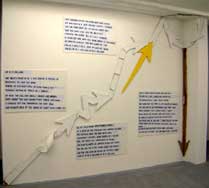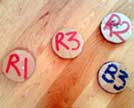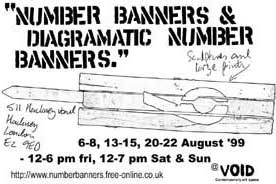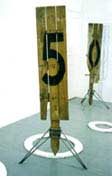| I made these banners 15 years ago; how time flies. I used them to mark out situations, and then experimented with cardboard arrows in an attempt to animate some life into the banners.
They were in a show at VOID gallery, London and in a small space in Digbeth, Birmingham. It’s only in the past few years that computer technology has made it easy to convert a series of images into an animation, so I created this video from scanned prints and photos. |
Installations
Number banners animations
| [youtube=http://www.youtube.com/watch?v=Xqvc0ts6uLg&w=300&h=243] | I made these banners 15 years ago; how time flies. I used them to mark out situations, and then experimented with cardboard arrows in an attempt to animate some life into the banners.
They were in a show at VOID gallery, London and in a small space in Digbeth, Birmingham. It’s only in the past few years that computer technology has made it easy to convert a series of images into an animation, so I created this video from scanned prints and photos. |
Number banner situations
Number banners animations
| [youtube=http://www.youtube.com/watch?v=Xqvc0ts6uLg&w=300&h=243] | I made these banners 15 years ago; how time flies. I used them to mark out situations, and then experimented with cardboard arrows in an attempt to animate some life into the banners.
They were in a show at VOID gallery, London and in a small space in Digbeth, Birmingham. It’s only in the past few years that computer technology has made it easy to convert a series of images into an animation, so I created this video from scanned prints and photos. |
Number banner situations
Music hall situations
 Century gallery
Century gallery
Cremer Street, London, E2 8HD
Apr 9 – 19, 2003
An exhibition of arrow installations.
Using scenarios gleaned from Music hall lyrics and pros I used my Number banners to explore a local historical feature in this part of East London.
The Century gallery exhibition was an exhibition of coloured arrows accompanied by text.
Arrows mapped out the movement and actions of scenarios described in old music hall songs. As situations, such as going up in a balloon, we described in a song, the arrows illustrated the movement and attitude of people and characters.
The overall effect was to create a feeling of action and dynamism that was described in the songs.

The four music hall songs
I chose two music hall songs: “Up in a balloon” and “The Valet”.
Artist’s statement
Paul Doeman is a London-based artist, whose artwork is both urban and conceptual in style. Paul creates work in all media, including two and three dimensions; art and its creation can be seen as the use and application of tools. It is possible for the tool to become the subject art, and, it with this in mind, Paul uses situations, scenarios and stories to imbue life into tool-like art objects.
Calling on various themes for the subject of his work, which is often tool-like and practical in both purpose and appearance, Paul has exhibited at numerous solo and joint exhibitions. ‘Number Banners’ have frequently become the subject of area-specific installations at art galleries throughout England; this is also true of the Century gallery show.

Century gallery exhibition: “Music hall situations”
Using scenarios gleaned from Music hall lyrics and pros, Paul has again used Number banners to explore a localised feature.
The history of Music hall has strong ties with the area of East London where the Century gallery is situated.
Before the popularity of TV, Radio and the growth of the WWW, Music hall was one of the ways in which East Londoners relaxed and enjoyed themselves; popular Music hall songs were the pop music of their day.
Applying Number banners to Music hall scenarios illustrates, and takes literally the words of the entertainment and assumes these things really happened, or at least, what happens when Number banners are used as a proxy on behalf of the art viewer and the artist.
If there is an art form to which Britain can justly and proudly claim to have given birth, it is the music hall.
“A living entity of boundless vitality, it was a child of dubious parentage, whose father was the drawing-room ballad – the soirée motto song – the nationalistic air, and whose mother was the folk tune – the raucous carouse – the tender love song. This enfant terrible had all the disadvantages of being born on the wrong side of the blanket, yet despite this, and perhaps even because of this, it thrived upon sentiments of every stratum of society in an age when Britain was awakening to the realization of Empire. The infant music hall had but one watchword – ‘flamboyance’ – fired by an innocent, and as yet uninhibited, passion.”
End of lawn bowls
 Creative Space, Field Row, Worthing.
Creative Space, Field Row, Worthing.
8-21 July 2002
An ‘end’ of Lawn bowls. Since Worthing is famed for its appreciation of the game of bowls, it seemed logical to pay homage to the game.
Number Banners & Diagrammatic Number Banners @ VOID

Number banner situations and diagrammatic number banners
VOID gallery Hackney, London.
August 1999
511 Hackney Road, London E2 9ED
The Exhibition provided a first chance for Number Banners to be displayed in a public art gallery and consisted of several number banners, number banner arrows, Diagrammatic Number Banners and 2 number banner situations.

Figure-of-eight
10 interlocking arrows complete a figure-of-eight eternal cycle. When this dynamic arrow sculpture is placed on the floor more than one Number banner can be put onto or near the device to create a progression or a single movement for the Banners.
At Void Contemporary Art Space figure-of-Eight arrows were placed on the wall, but displayed without number banners this creation can stand on its own; exhibited as an item rather than in action.
Figure-of-eight text assisted this arrow set-up, it was displayed along-side the art piece and written in the stencil letter font >>
This work – like other number banner installations – describes dynamic movements and other dynamic qualities of the number banners. Their purpose is to be used for experiments in time and space; examining the first four physical dimensions: Time, length, breadth and height. It is important that the Number Banners are seen as having individual personalities in their own right as their ‘value’ affects the way that they act on the arrow set-up.
In the case of Figure-of-eight arrows the ten arrows can be seen as a reflection of the ten Number banners this is unusual as not all arrow set-ups contain ten arrows. This arrow set-up looks similar to a Scalextric track. In the child’s car game cars race around a track that has metal slots that conduct electricity to toy cars. Although with Scalextric the user determines the speed of movement for the cars, Figure-of-eight-arrow set-up allows the Number banners to travel without user assistance, the arrow set-up infers the Banners movement.

Twist arrow
In this situation the number banner spins, it needs to be imagined that the floor is not physically present. The banner is travelling in the direction of the pointed arrow.
This arrow really affects the appearance and so the personality of the number banner that is placed within it.
This is another example of the partnership between number banners and the cardboard directive creations.
Cardboard arrows give number banners direction and purpose, these cardboard circles offer islands for number banners to jump to.
Again, these cardboard constructions give a potential dynamism to the otherwise static banners. Number banner 5 was placed on the edge of one of the circles and the rest was left up to the viewer.


















